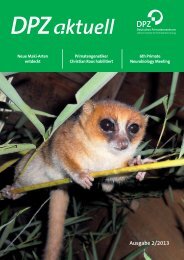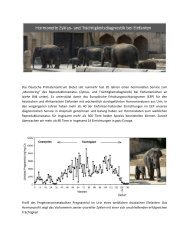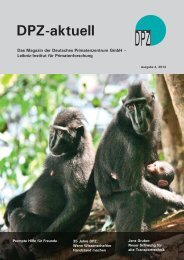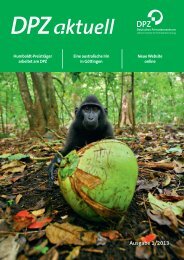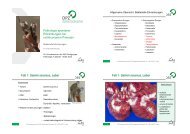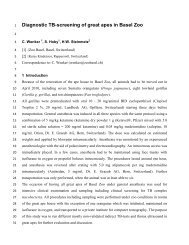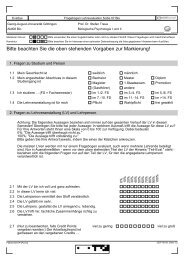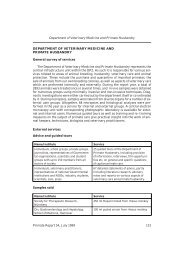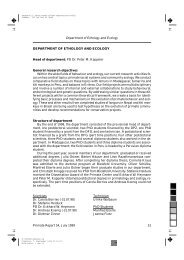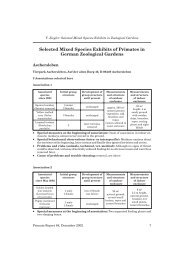Vol. 15 - Deutsches Primatenzentrum
Vol. 15 - Deutsches Primatenzentrum
Vol. 15 - Deutsches Primatenzentrum
Create successful ePaper yourself
Turn your PDF publications into a flip-book with our unique Google optimized e-Paper software.
Page 60 Lemur News <strong>Vol</strong>. <strong>15</strong>, 2010<br />
of forest cover and fragmentation of suitable habitat (Harper<br />
et al., 2007) which limits the species’ density and range<br />
(Glessner and Britt, 2005). Although protected, the Babakoto<br />
is also threatened by subsistence hunting pressure and<br />
bush meat trade (Golden, 2005). Designated as Endangered<br />
according to the IUCN Red List of Threatened Species<br />
(IUCN, 2008), I. indri is currently split into two subspecies,<br />
Indri indri indri (Gmelin, 1788) and Indri i. variegatus (Gray,<br />
1872). Here, we present population genetic parameter estimates<br />
from populations along the entire range of the species<br />
analyzed from nuclear microsatellite multilocus genotypes.<br />
Methods<br />
Samples were collected from 106 Indri from 10 sites across<br />
the geographical range of the species (Fig. 1). From north to<br />
south,the forests represented in the collection were Anjanaharibe-Sud<br />
Special Reserve, Marotandrano Special Reserve,<br />
Ambatovaky Special Reserve,Zahamena Special Reserve and<br />
National Park, Betampona Nature Reserve, Anjozorobe<br />
Regional Forest Reserve, Mantadia National Park, Analamazoatra<br />
Special Reserve (Andasibe),Maromizaha Classified<br />
Forest, and Anosibe an’ala Classified Forest. The elevations<br />
of the sampling sites ranged from lowland forests (Anosibe<br />
An’ala, 125 m asl) to highland forests (Anjozorobe, 1358 m<br />
asl).<br />
Fig. 1: Map of Madagascar indicating the study areas.<br />
Immobilization and collection<br />
All lemurs investigated in this study were free-ranging and<br />
were immobilized with a CO2 powered DAN-INJECT (Brrkop,<br />
Denmark) Model JM rifle propelling Pneu-Darts (Williamsport,<br />
PA) loaded with 10 mg/kg estimated body weight<br />
of Telazol ® (Fort Dodge).We recorded the location (within 6<br />
m accuracy) of all of the immobilized lemurs using a global<br />
positioning system (GPS) device. Each individual was transported<br />
back to the base camp where complete morphometric<br />
data were taken (Zaonarivelo et al., 2007a). Whole<br />
blood (1.0 cc per kilogram) from the femoral artery and<br />
2.0 mm skin biopsies from the ear pinnae were collected<br />
from each sedated lemur (Junge and Louis, 2002). A Home<br />
Again ® (Home Again Pet Recovery Service, East Syracuse,<br />
NY) microchip was placed subcutaneously between the scapulae<br />
of each lemur to positively identify individuals re-captured<br />
during any future immobilizations. Following data and<br />
sample collection, an injection of lactated Ringer’s solution<br />
was administered subcutaneously to support maintenance<br />
requirements and to dissipate the effect of the Telazol ®.Animals<br />
were monitored for three hours post recovery then<br />
released according to the capture GPS coordinates.<br />
Data generation<br />
Ear punches were dissected into quarters and DNA was<br />
extracted using standard PCI/Chloroform procedures (Sambrook<br />
et al., 1989). Approximately 50 ng of genomic DNA<br />
was used for each PCR reaction. Multilocus genotypes were<br />
generated from a suite of 20 Indri-specific microsatellite loci<br />
as described in Zaonarivelo et al. (2007b). The genotype file<br />
was checked for typographical errors,scoring errors,stutter<br />
bands and allele dropout with Micro-Checker (van Oosterhout<br />
et al., 2004) and Microsatellite Analyser (MSA; Dieringer<br />
and Schlötterer, 2002). We used CERVUS (version 2.0,<br />
Marshall et al.,1998;Slate et al.,2000) to identify loci with excessive<br />
null allele frequency estimates (nf > 0.10) and to estimate<br />
polymorphic information content of the loci.Moderate<br />
(0.05 < nf < 0.20) and high (0.20 < nf) null allele frequencies<br />
can have significant effects on population genetics parameter<br />
estimates (Chapuis and Estoup, 2007). The process of redesigning<br />
primer pairs is both costly and time consuming;<br />
therefore,we opted to delete problematic loci from the data<br />
set. We deleted eight loci with moderate null allele frequencies<br />
(nf > 0.1) to reduce the bias from misclassification of null<br />
heterozygotes as homozygotes (Callen et al., 1993; Hoffman<br />
and Amos, 2005) and to control the variance of parameter<br />
estimates (Chapuis and Estoup, 2007). The accepted loci<br />
were verified for independence of linkage disequilibrium<br />
(with Bonferroni-adjusted P-values) in FSTAT (Goudet,1995,<br />
2001).<br />
Hardy-Weinberg exact tests (Guo and Thompson, 1992)<br />
were performed by locus and population in Genepop (version<br />
4.0, Raymond and Rousset, 1995). Initially, we used the<br />
default settings for the MCMC estimation of HWE then<br />
increased the batch size from 100 to 250 to reduce the standard<br />
error of the P-value to below 0.01. Genetic diversity<br />
was measured as observed heterozygosity (HO) and expected<br />
heterozygosity (HE). In addition, the number of effective<br />
migrants was estimated globally and pair-wise using the private<br />
allele method. We used FSTAT to calculate the total<br />
number of alleles (k), mean number of alleles (MNA), and<br />
rarefacted allelic richness (AR; Leberg, 2002) by locus and<br />
population.Allelic richness estimates the allelic diversity in a<br />
data set based on the population with the fewest number of<br />
individuals contributing genotypes by locus. This is an unbiased<br />
comparison of allelic diversity since populations with<br />
more contributors provide a greater opportunity to capture<br />
more alleles from lower frequency occurrences. Wright’s Fstatistics<br />
were estimated in FSTAT for within population<br />
similarity (FIS) and between population differences (FST)<br />
according to Weir and Cockerham (1984).<br />
The effective population sizes were estimated with the linkage<br />
disequilibrium (LD) option in NeEstimator (Peel et al.,<br />
2004; Hill, 1981; Waples, 1991). We tested all populations<br />
having met the minimum statistical threshold required (n =<br />
20 genes or 10 individuals) for the presence of bottleneck<br />
events using Bottleneck (version 2.0, Cornuet and Luikart,





